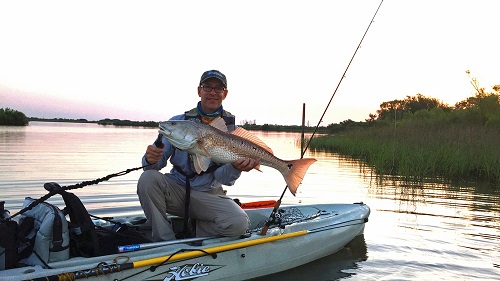 When preparing for your kayak fishing trip I’m sure your thoughts were on the weather and what lures the fish are biting, but the success of a trip is so much more than the forecast and the sold out hot lure of the month. Yes, that stuff is important, but without the proper accessories you may as well cast that expensive lure in a swimming pool. After several years of trial and error the kayaking community is rigging smarter. Setting up your kayak is as personal as a pair of shoes so take a look at these must have items to make your next trip an even better success.
When preparing for your kayak fishing trip I’m sure your thoughts were on the weather and what lures the fish are biting, but the success of a trip is so much more than the forecast and the sold out hot lure of the month. Yes, that stuff is important, but without the proper accessories you may as well cast that expensive lure in a swimming pool. After several years of trial and error the kayaking community is rigging smarter. Setting up your kayak is as personal as a pair of shoes so take a look at these must have items to make your next trip an even better success.

There are so many accessories for today’s kayak angler like fish finders and rod holders. What’s really important for a successful redfish trip along the gulf coast comes down to the fundamentals like getting there and positioning yourself properly to cast to fish.
The MirageDrive has been critical to my fishing strategy over the years. Making twenty mile trips in one day or towing a stranded motor boat to a safe bank (sounds ridiculous but that’s just the tip of the iceberg) is possible for me to do. Battling the current with this must have item helps you bring that fancy lure to the fish. So starting out with number one on a must have list is the MirageDrive that comes with several Hobie kayak models.
Proper Positioning
Now that you have made it to your fishing grounds, how do you stop moving and start fishing? This is something most people ask as they are gliding into a tree branch filled with bees or whatever worst case scenario that flashes through your mind. Anchoring is a critical element to catching fish especially if the boat can be positioned properly. In deep water with some current, the fluted sand anchor which is great for grabbing sand/soft bottom and can be attached to the kayak by clipping off to your anchor trolley. One accessory that helps this style anchor hold onto the bottom is a short piece of two foot chain which is in proportion to the current and weight of the anchor. In deeper water with oysters and hard bottom you need a grappling style anchor with prongs to grab bottom as you drift back. When chasing large powerful fish like the bull redfish an anchor buoy tied to the end of your anchor line is a quick and easy way to release the anchor from the kayak allowing you to fight the fish untethered. Anchor balls or buoys can save the day if a big redfish starts peeling off drag and you need to chase it down. Once the fight is over, the anchor buoy should be at the same spot and you can go back to fishing that exact spot after landing your fish.
Shallow waters present a different set of positioning challenges. First on my shallow list is the old fashioned stakeout pole tied to anchor trolley. Also is a great option for pushing through oyster shells especially the Hobie brand stakeout pole with the metal tip. This accessory is simple, light and quiet to use because it just needs to be pushed into bottom. An added bonus is that you can stake out and instantly start casting without worrying about it grabbing the bottom like an anchor has to.
When drifting over deeper water where you can’t quit reach the bottom with the pole then pull out the same folding anchor used out in deep water. The down side is every time you pull the anchor in mud or grass gets everywhere. So, to reduce the mess, simply keep the anchor in the closed position with the flutes locked. The anchor works fine as long as the current is light.
Controlling Drift Speed
Drift socks or “sea anchors” have also been around for a while and are useful on sailboats to keep them under control if something important (sail or kicker motor) breaks. These mini parachutes can help catch more fish by controlling the speed of a drift. By deploying a drift chute, the kayak can be slowed down to fish a certain area longer, but still continue to cover water. The best time and place for a drift sock is high tide with lots of wind. The fish tend to scatter in those conditions so covering several miles of shoreline can be unproductive if you’re constantly repositioning any kind of anchor. Position the kayak across your favorite marsh flat with the drift sock clipped onto the anchor trolley and run the clip to the back of the kayak. A high quality sock only weighs a few ounces and folds down to the size of a water bottle so think of it as a fishing tool for windy days.
The backbone of a kayaks anchoring system is the anchor trolley with the ability to run a bottom anchor to the stern or clip on a drift sock. Another advantage over a tie off cleat is the ability to pull the cable and adjust the anchor point which spins the kayak into a more favorable casting position. By matching the anchor up with your terrain and putting some thought into how you fish, then you will spend more time fighting fish instead of fighting the elements.

